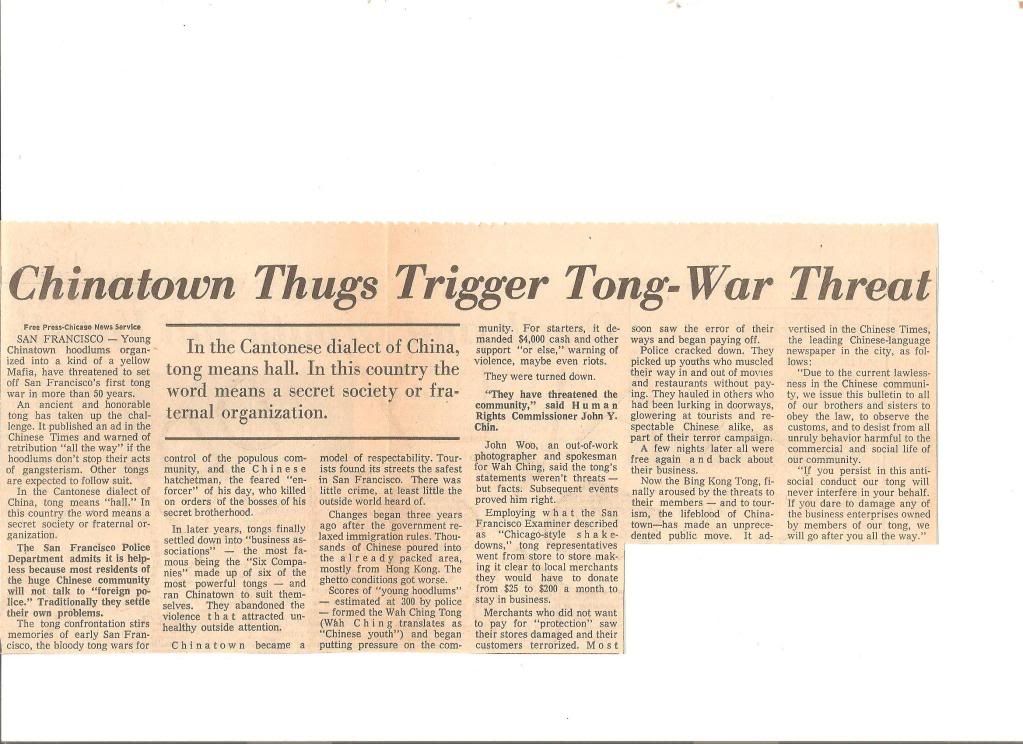Not too long ago, I purchased a copy of Detective Fiction Weekly (formally baring the Flynn's banner), issued the ninth of January, 1932. I ordered this issue specifically for the Sidney Herschel Small cover-story "Fireflies of Death." Stories of tong violence, the gang wars between rival Chinese secret societies in Chinatowns throughout the country during the earliest years of the last century, factor heavily into my current historiographical research, and make up a great bulk of my pulp purchases, as of late.
Upon receiving the issue, and opening its pages, a folded and somewhat yellowed newsprint clipping fell from between the cover and the first page of the periodical. It was from the Detroit Free Press, dated August 4, 1971.
 | |
| Detroit Free Press - Page 8-A - Wednesday, August 4, 1971. |
I found it immensely fascinating that a newspaper clipping, obviously removed from the rest of the paper with care, should be stuck between the pages of a nearly eighty-year old pulp, which featured a tong story on its cover, no less. Such placement produces a list of possible scenarios and reasons as to why it was there; questions that get to the very heart of my love of history and popular ephemera such as the pulps.
Was it placed by a secondary, or even tertiary owner of this magazine in later years, for some reason? Was it placed by a recent owner, to give a little mystery to the issue, and to create such thoughts and mental wanderings as I elucidate in type now? Or was it (what I like to believe is the case) that the original owner of this magazine, a boy or young man when it was first released, cut out this story and placed it within those pages decades later, as a kind of remembrance of the tales he marveled at in his youth?
It is, obviously, impossible to know the truth, and that is precisely what I find the most interesting. It is such speculation, concerning the past, that popular literature of bygone days provides for its posterity, the idea that you hold something that, monetary values aside, meant a great deal to someone, for one reason or another, in the past and, for whatever purpose, meant something to them over forty-years later. It is a tie to the past that no textbook, no recorded media, and certainly no "app" can provide: tangible, physical memories of someone, albeit however anonymous, and however ambiguous. To most, such a discovery would mean little; to the historian (and romantic, I can freely admit), however, such ephemera is invaluable.
Such things are but a few, of the many reasons, I care for the pulps; out of curiosity, would anyone else like to share their reasons, or have similar instances of wondering about a pulp's history, aside from its physical existence?


I've bought western pulps where the previous owner, evidently a farmer, wrote the prices of various produce in the pages of the magazine.
ReplyDeleteAnother interesting case involved Fred Fitzgerald of Festus, Missouri, who had an enormous collection of pulps, all bought off the newstands in the 1925-1945 period. He often would write his name on the cover and then circle in colored crayon various words in the stories. Perhaps he was interested in writing stories. When he died, his widow started selling the thousands of pulps for cover price in the late 1960's. The first few collectors were not thinking straight and simply picked out some hero titles, etc. Then Nils Hardin, the future publisher of the pulp fanzine, XENOPHILE, discovered this treasure trove and bought entire runs of such titles like ADVENTURE, ARGOSY, SHORT STORIES, BLUE BOOK. He then sold them for 25 to 50 cents each to Harry Noble, a friend of mine, who then sold them to me for a couple bucks each in the 1970's. Now, they are worth alot more of course.
I've also run across issues where the interior illustrations were colored in crayon by a previous owner. Since the late 60's, I've written thousands of notes and put them in my pulps, rating the stories, date read, and comments about the quality,etc.
I think it must be that I come to pulp collecting, as a comic collector as well, so I can't imagine actually writing in them (anyone who reads this, and is on the PulpsMag mailing list can attest to my concern as to the condition of my pulps). Then again, I don't really write in any book I have, and always hated getting used books for class that had been highlighted and whatnot.
ReplyDeleteAnd that bit, about Mr. Fitzgerald, is exactly what I mean, when I speak about knowing something you hold in your hands had a profound importance to someone in the past - whatever those issues monetary value in and of themselves, such notes, in my mind, make them infinitely more valuable.
That's so fascinating. Sidney Herschel Small was my great grandfather on my dad's side. Grandpa used to talk about how they as a family would go to Chinatown in San Francisco to have dinner with friends of his father that were Chinese. Maybe that's where he got his information. They lived in the bay area.
ReplyDeleteAnyway, glad his stories are still entertaining people.
Lillian J. Small